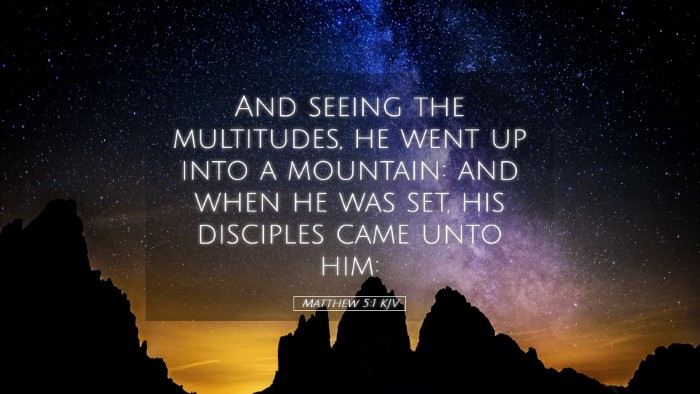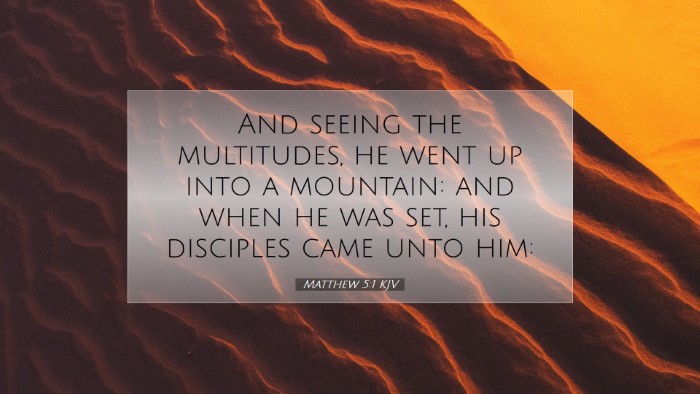Commentary on Matthew 5:1
Verse Reference: Matthew 5:1
"And seeing the multitudes, he went up into a mountain: and when he was set, his disciples came unto him."
Introduction
This verse serves as the introduction to the Sermon on the Mount, one of the most profound teachings of Jesus recorded in the Gospel of Matthew. In this commentary, we will explore the contextual, theological, and practical implications of Matthew 5:1, drawing from various public domain commentaries such as those by Matthew Henry, Albert Barnes, and Adam Clarke. These insights aim to enrich the understanding of pastors, students, theologians, and scholars.
Contextual Analysis
Setting: The setting of this verse is vital to understanding its significance. Jesus "seeing the multitudes" indicates His awareness of the people around Him. The multitudes represent a diverse group consisting of followers, skeptics, and curious onlookers. As Henry notes, this moment demonstrates Christ’s compassion and purpose in teaching the vast assembly.
Geographical Significance: The mountain to which Jesus ascended is meant to symbolize a place of instruction and revelation. Ancient tradition holds that mountains are often places where divine encounters occur. Adam Clarke points out that by going up to a mountain, Jesus sets a distinct stage for His teachings, invoking the imagery of Moses receiving the law on Mount Sinai — a supreme moment of divine instruction and covenant.
Theological Implications
Jesus as Teacher: The movement to a higher place signifies the elevation of His teachings. By sitting, a common posture for teaching in Jewish tradition, He demonstrates authority. Barnes writes that this sitting position emphasizes His role as a teacher, indicating the importance of the lessons to come. The Sermon on the Mount encapsulates ethical teachings that form the foundation of Christian living.
Discipleship: The disciples’ response—coming to Him—indicates a readiness to learn and a recognition of Jesus' authority. Henry highlights that true discipleship involves both coming to Christ and sitting at His feet to receive instruction. This response is foundational for anyone truly seeking to follow Jesus amidst the multitude.
Practical Applications
This verse not only sets the stage for the teachings that follow, but it invites reflection on our own lives.
- Seek Solitude for Learning: Just as Jesus withdrew to a mountain to teach, we are encouraged to find solitude away from distractions, fostering an environment conducive to receiving spiritual truth.
- Recognize the Multitudes: As Jesus was aware of the vast audience, pastors and leaders should also be sensitive to the needs and backgrounds of those they minister to, being prepared to address their hearts.
- Discipleship Commitment: Like the disciples, we must approach Jesus with an eagerness to learn and apply His teachings in our daily lives. Clarke emphasizes that coming to Jesus is the first step in a lifelong commitment to follow His ways.
Conclusion
Matthew 5:1 encapsulates a pivotal moment where Jesus transitions from the multitude's awareness to focused discipleship. By ascending the mountain, He prepares to reveal divine truths. Pastors, students, theologians, and scholars can glean profound insights from this passage, recognizing the call to higher living through deeper learning. As they reflect on this verse, may they be inspired to engage in solitude for spiritual growth, reach out to the multitudes with compassion, and commit themselves to the path of discipleship.


